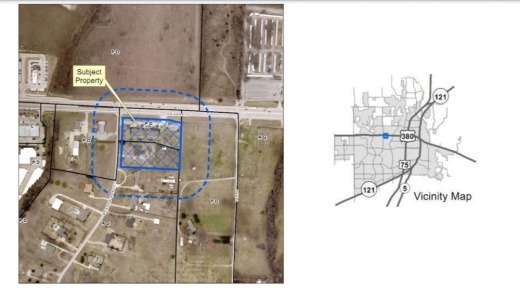At its Nov. 16 meeting, council approved a request to rezone about 4 acres located at the southeast corner of Meadow Ranch Road and US Hwy. 380 from an agricultural district to a local commercial district.
Multiple residents came to the Nov. 16 meeting to speak in opposition to the project. Concerns cited included a lack of cooperation between the developers and the residents, as well as an increase to the traffic through the neighborhood.
The applicant, Martin Sanchez with Sanchez & Associates, said there is not a specific plan for what will be developed at this site, but understood the concerns from the neighborhood south of the project area along Meadow Ranch Road. He said that there have been significant efforts to work with the residents of Meadow Ranch Estates, overseen by city council members, but that these conversations had stalled and become unproductive after a point.
For instance, residents had presented him with a list of suggested prohibited uses for this area, which he said he agreed with “the majority of them.” There were a few, he said, that he questioned, but did not outright object to. For instance, dry cleaners and a paint store were suggested prohibited uses on this site, and Sanchez wanted clarification on why these should be prohibited. However, his questions were seen as pushback from the residents, he said.
“We haven’t been able to get to any meaningful end on this,” Sanchez said.
Council member Geré Feltus said she was disappointed with where the discussions had wound up. Sanchez had shown residents and some council members a plan where if the area was not rezoned, his client instead has a plan that includes four separate buildings—two on the north tract and two on the southern tract—Feltus said. This plan meets the current zoning for this area and would push traffic through the gate on the north that separates the existing vet clinic from the neighborhood.
“It was implicitly stated on both sides that this is the plan we do not want to see,” Feltus said.
Instead, what those at the meeting agreed to was a plan to make the gate meet on both the east and west sides of the property and then have a single, solid building fronting US 380 and as far away from the neighborhood as possible, she said.
“We walked out of that meeting thinking that we were literally a couple of days from a solid agreement, and there's just a few things that got pushed back on and, in all honesty, it blew the whole thing up,” Feltus said. “My concern is that adding more time is not going to provide us much of anything. So we have to move forward with what makes sense.”
She said she wanted to see the wall go all the way across the property to help prevent through-traffic from US 380 and that she did not want to see more buildings on the property. Sanchez nodded as Feltus made these recommendations and said “absolutely.”
Feltus also highly recommended that Sanchez and his client provide a deed restriction to the properties adjacent to the site for residents’ peace of mind, though officials pointed out that this was not something the council could require.
Sanchez noted that, in his letter of intent to city staff, he included a number of uses that would be prohibited with the new zoning. This included uses such as a bait shop, a bus station, drive-thru restaurants, halfway house and more. It also included landscape requirements and site development standards.
After more than an hour of discussion, the rezoning request was approved by council. Just after the vote, Mayor George Fuller pointed to the city’s new development code that is in the works and will come into effect in the summer. The new development code would allow more uses on the property that residents may object to if it remained in its current zone.
“There's a lot of discussions being had that people are not aware of all the conditions that exist. Our job as an elected official is to actually research those things and identify those things and make a decision knowing all those conditions and analyzing all those conditions and analyzing what does the no vote potentially put on that space? What does the yes vote put on that space?” Fuller said. “It's understanding all of the information and making a decision we feel is in the best interest of the city.”





